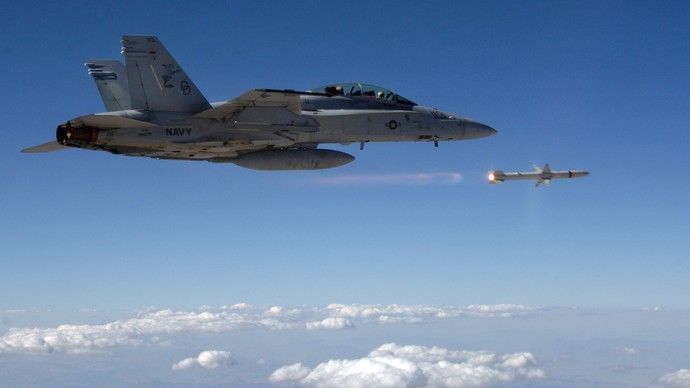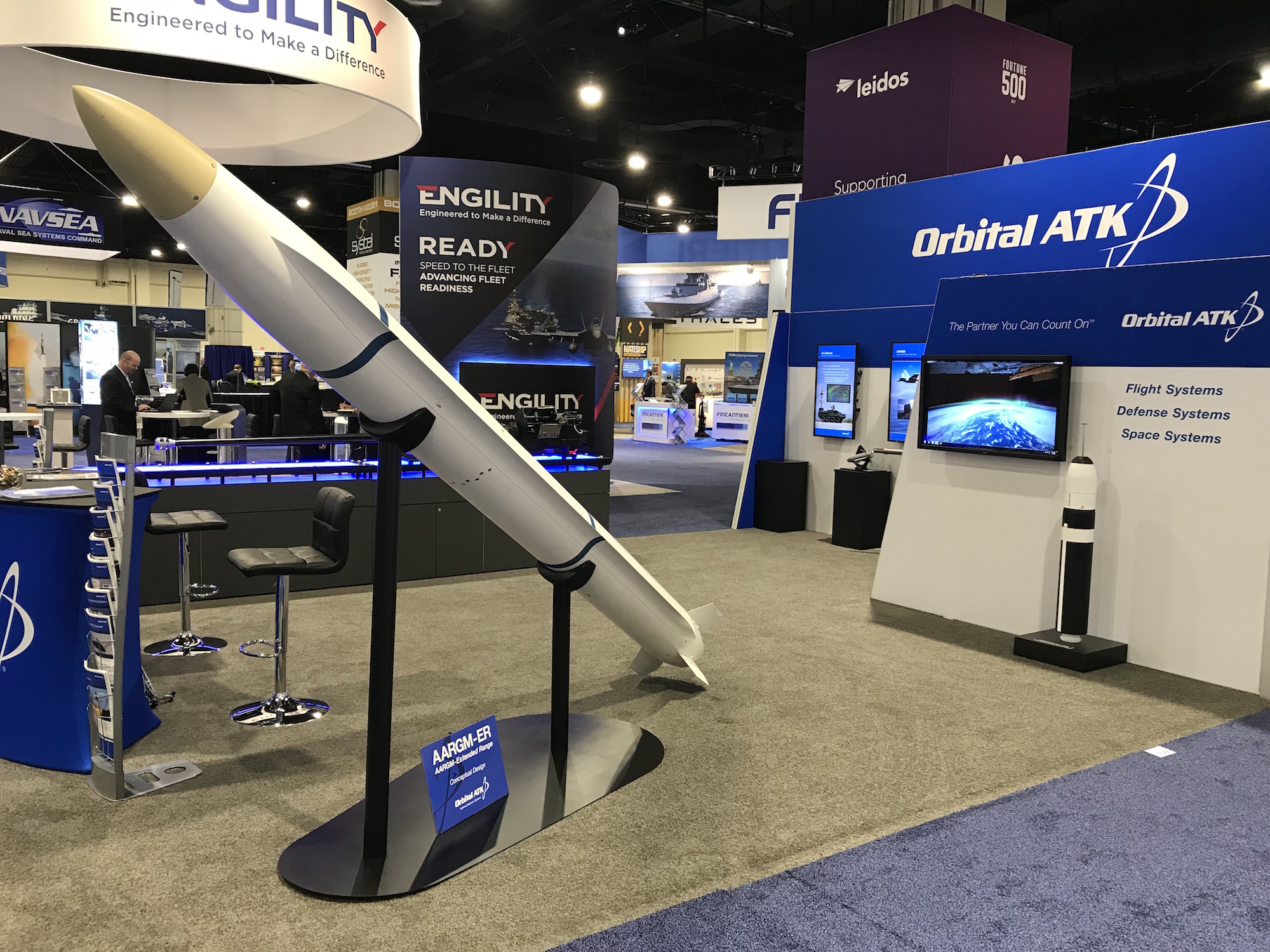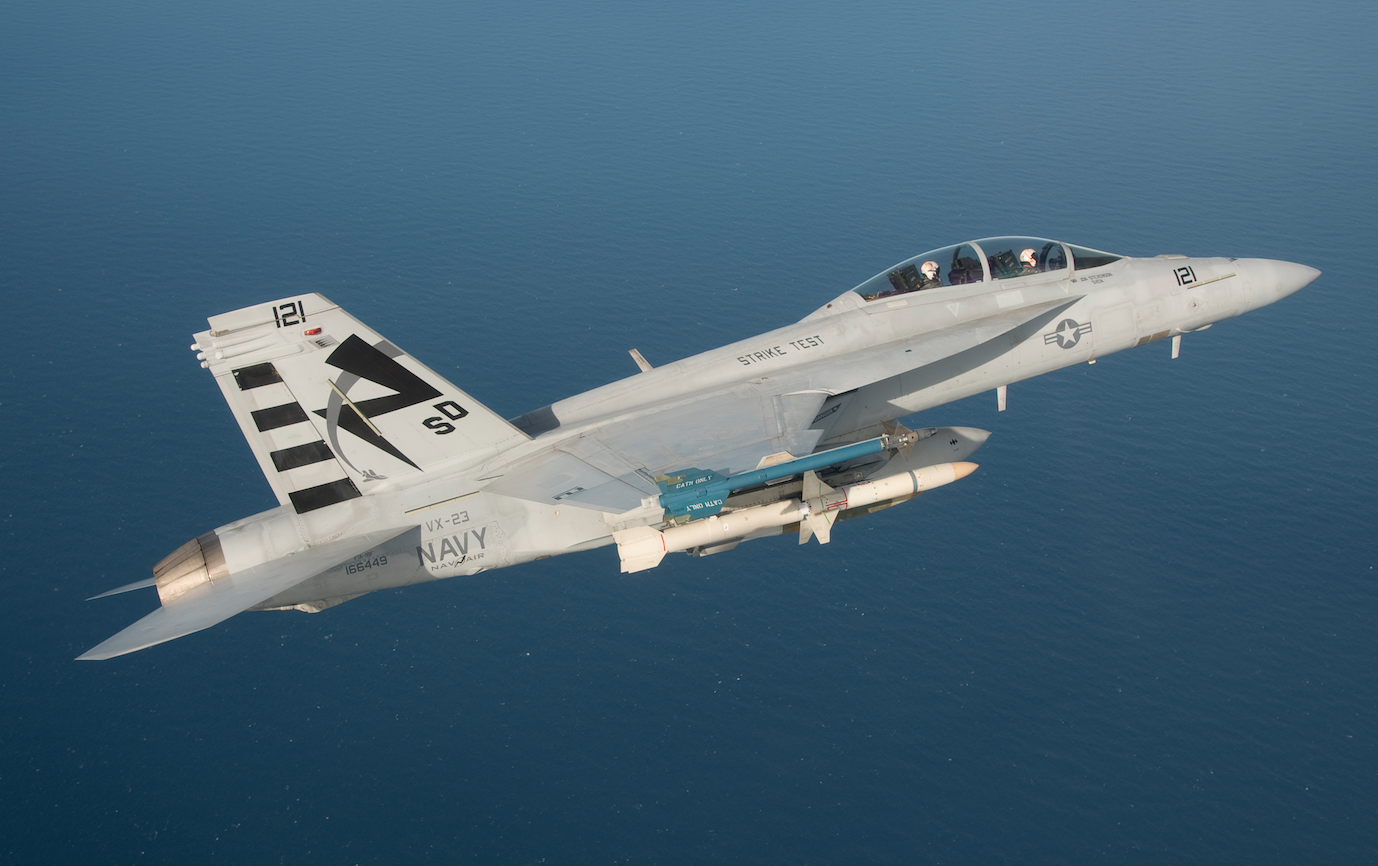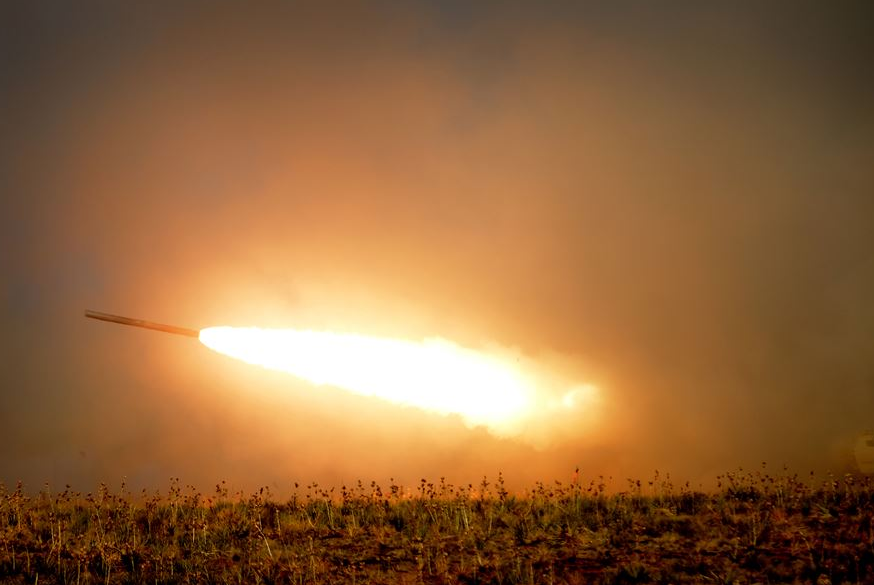AARGM - Evolution of Anti-Radiation Capabilities

The US Navy is gradually introducing more AARGM anti-radiation missiles into its inventory. The missile in question is being continuously modified, so that it is always up to date and compliant with the ever-changing battlefield requirements. At the same time, work has been initiated to develop the next generation AARGM-ER missile. Its combat performance is expected to be significantly enhanced, and, what is more, the F-35 is going to be able to carry it as an internal store. The FY2019 Department of Defense Budget Request outlines the details of the said process.
AARGM missiles are currently used by the US Navy and USMC. The weapon has been integrated on F/A-18C/D/E/F Hornet/Super Hornet and E/A-18G Growler aircraft. Full scale production of the AARGM began back in 2012, while 500th missile was handed-off to the US Navy on 31st May 2017. Three months later another contract was signed, to manufacture the sixth series-production lot of the AARGM missiles.
Within the framework of the above contract, the AGM-88B HARMs are going to be upgraded to the AARGM standard – here we are speaking of 230 live and 6 inert (training) missiles. This is because the US Navy still remains in possession of the older HARM missiles that could possibly be transformed into AARGMs.
AGM-88E has been fitted with a new multi-sensor seeker and new flight control system. Nonetheless warhead, overall missile design and some of the elements of rocket propulsion remain common between the two models mentioned above. As the missiles are available, the new ones can be introduced at a fraction of the cost usually associated with manufacturing of a brand new missile.
AARGM’s seeker includes three separate modules working together: passive radar, millimetre radar and INS/GPS. The above makes it possible to neutralize moving targets or objects that do not emit radar signals, in case of which the coordinates are known.
The US Navy, working together with Orbital ATK (company which acts as the industrial partner of the AARGM programme), is taking steps to enhance the combat capabilities of the missiles in a continuous manner. In November 2017 the US Department of Defence asked Orbital ATK to conduct an engineering study and plan tests related to the existing components and subsystems of the AARGM missile. This was done on the basis of two contracts.
The scope of former contract, concluded within the framework of Small Business Innovation Research (SBIR), includes the area of “Secondary Sensor for Anti-Radiation Missiles.”. The research mentioned above is planned to be completed until February 2019. The second contract, with a value of 17 million dollars, assumes that similar works would take place. However, in this case the completion of the new generation AARGM-ER missile programme would be assessed, along with the concept of potential use of the AARGM components in the AARGM-ER missile.

AARGM-ER is a programme aimed at developing a new generation anti-radiation missile for stealth aircraft. The Extended Range variety is to use seeker, warhead, sensors and guidance system of the current AARGM, and fuse these components with the modernized propulsion section. The missile is going to be redesigned as well.
AARGM-ER is to feature strakes oriented longitudinally and thermal protection layer, to accommodate for speed which is going to be much higher than in case of AARGM. Vertical surfaces (stabilizers), on the other hand, would be eliminated. It is assumed that the range is going to be twice as long, in comparison with the current AARGM effector. AARGM-ER is to be tailored to fit in the internal weapon bays of the F-35.
According to the information included in the FY2019 Budget Request, AARGM-ER is expected to reach IOC (Initial Operational Capability) in 2023. Two years before that, LRIP contract would be signed (Low Rate Initial Production). The document mentions the relevant data pertaining to manufacturing and development of the AARGM and AARGM-ER missiles.
The Budget Request stresses the fact that the missile shall have „extended range, survivability and effectiveness against complex, new, and emerging threats.” The information available to the eye of the beholder suggests that AARGM-ER is to increase survivability of both the carrier platform (without compromising its RCS when the missile is carried inside the internal weapons bay) as well as the missile.
FY2019 Budget Request declares that the first procurement funds would be assigned to the AARGM-ER programme in 2021. Meanwhile, 252 AARGM mod-kits are planned to be acquired in FY2019 too, for an amount USD 143.9 million. The acquisition also includes other components, including containers, telemetry hardware or auxiliaries. 188 million dollars have been allocated to AARGM procurement in total.
AARGM Development Efforts – FY2019 Budget
The US Navy also plans to develop the capabilities related to the existing AARGM missiles, as well as to the AARGM-ER programme. The 2019 Budget Request, in the Research and Development assumes that 120.76 million dollars would be used to carry out the anti-radiation weaponry programmes. The funds have been divided into three sub-programmes, one related to general modernization of all anti-radiation assets (6.25 million dollars), second one tied to the AARGM missile (15.26 million dollars) and third one, pertaining to the AARGM-ER effector (99.24 million dollars). The DoD also suggests that the Joint Service Anti-Radiation Missile Programme mentioned above also covers „near and far term performance improvements, cost reduction, and studies that establish future development requirements.”
Furthermore, the whole initiative also covers modifications and upgrades for the armament that is already in service, or for systems in case of which series manufacturing has been approved. The first programme – ARM Improvement – is focused on the effort related to modernization of HARM and AARGM effectors. The budgetary bill notes that the work forms a requirement to carry out “periodic updates to the user data base based on changing threat parameters (…) and emerging systems”. The funds also make it possible to carry out tests of the anti-radiation missiles against Foreign Material Assesments, FMA.
Thus, the radars in the missile may be adopted to address the evolving threats. The FY2019 budgetary bill also assumes that extra test capacity shall be established to verify the operation of the digital passive AARGM’s seeker and its millimetre radar. FMA tests planned for FY2019, as well as the engineering efforts, are to maximize the AARGM’s and HARM’s effectiveness against IADS threat.

When it comes to AARGM, it was last year when Block 1 Software Upgrade effectors were introduced. Block 1 missile had been fired in 2015, also in order to check whether it would be capable to act against moving marine targets.
Between FY2019 and FY2023 it is expected that AARGM’s capabilities would be extended and demonstrated within the scope of destroying „non-traditional and Overseas Contingency Operations targets.”
AARGM’s ability to navigate in tough conditions is also going to be developed and enhanced at that stage too. FY2019 financing is also going to cover enhancement of radar data processing, to meet the requirements emerging along with new threats. FY2019 budgetary deal mentioned the target and threat database upgrades as well. Furthermore, funds have been allocated to integrate the military GPS system within the missile. The individual elements of the existing AARGMs are thus being developed continuously, along with the software.
AARGM-ER
In the meantime, in case of the AARGM-ER missile it is planned to conclude an agreement that would cover Engineering and Manufacturing Development phase. The missile is expected to be a part of the Navy Integrated Fire Control system designed for A2/AD scenarios. NIFC solutions are to enable the engineers to integrate the individual systems into an “kill chain”, which would translate into an ability to work in access-denial environments.
The systems are to make it possible to attack targets outside the radar range of the carriers (vessels and aircraft), which would translate into the US Navy’s ability to operate and control the warzone around the coastal areas. According to the Budget Request, such capabilities are particularly important, as the ever evolving threats require a broader scope of coordination to penetrate A2/AD theatres.
The experts suggest that littoral area denial zones include the Kaliningrad Oblast or the vicinity of Crimea which, just recently, became a part of Russia. A variety of surface-to-surface and surface-to-air missile systems remains present there, the purpose of which is to make allied operations in the Baltic and Black Sea regions difficult or even impossible.
The US Navy considers the counter-A2/AD capabilities to be one of the service’s priorities. It shall be noted that anti-radiation missiles may also contribute to own air superiority, if the adversary’s air force is based on ground-direction method, utilizing primarily ground early warning sensors. This kind of doctrine is used by the Russian Federation, where long range radars are an element of the A2/AD areas. Meanwhile the quantity and potential of own AEW platforms (A-50 for instance) remains limited. NIFC system also includes SM-6 anti-aircraft missiles that remain capable of attacking surface threats, along with a fire control system making it possible to fuse data from a variety of sources and sensors, including the F-35 new generation aircraft. Thanks to the doctrine mentioned above, the missiles may reach beyond the radar horizon accessible to the carrier vessels. This is especially important in case of low-flying threats, such as cruise missiles.
AARGM-ER would become a part of the prospective US Navy fighting system designed for A2/AD environment applications. The Drive recently claimed that AARGM-ER would be carried by the USAF F-35As.
Also, USAF recently initiated the Stand-In-Attack Weapon programme. “This project provides a strike capability to defeat rapidly relocatable targets that create the Anti-Access/Area Denial environment”, as the USAF FY 2018 Budget Request reads. F-35 and B-21 are to be the first platforms in case of which integration of the new missile is expected.
The initial funds related to this programme were planned to be spent in FY2018. During FY2019 43.175 million dollars is the amount allocated to this initiative. The project is still at its very early stage, with Milestone A expected during FY2019. At this stage, risk reduction and technology maturing processes would be taking place. It is assumed that the procurement procedure is going to be competition based – and this refers to the Engineering and Manufacturing Development phase too. Ultimately, the contractor is to be selected at the manufacturing stage. As for now, it is difficult to tell what solutions would be selected here, but AARGM-ER matches the assumptions at least to some extent.
It should also be added that FY2019 Budget Request also mentions one more anti-radiation system that is to be used by the US Army. It is assumed that between fiscal years 2021 and 2023, an anti-radiation seeker module shall be developed and integrated with the GMLRS surface-to-surface guided rockets.

Above: a missile is being launched from a HIMARS launcher. Photo: Staff Sgt. Matthew Plew/USAF.
The above would enable the US Army rocket artillery units to act against radars. Additionally, the number of both M270 MLRS and M142 HIMARS units is set to be increased. It shall be noted that artillery (with a range of 85 kilometres and with future prospects of reaching targets at distances of up to 150 kilometres) may be used to act against threats differing from the usual targets attacked with the use of air-to-ground anti-radiation missiles. In this case, the artillery would become a stand-off weapon.
This means that ground-based anti-radiation rockets could be used to act against threats different from the ones that are attacked by the airborne carriers of such weapon. Here we are referring to the firefinder radars deployed to the frontline and used to direct artillery fire against the enemy artillery, command posts and other ground-based radars.
The fact that the Army started to work on its own radar systems suggests that their significance on the battlefield is becoming greater. Furthermore, there is a need to develop mechanisms for cooperation and sharing the responsibility. On the other hand Polish Krab 155 mm self-propelled howitzers are also going to use anti-radiation munitions. Last year the Armament Inspectorate of the Polish MoD carried out a “technical dialogue” procedure within that regard.
AARGM Export Opportunities
AARGM missile is being currently offered as an export proposal by the US Authorities. Poland is among the potential customers. Warsaw would like to equip its F-16s with the missile. AARGM is also being integrated with the Italian Air Force’s Tornado jets. Italy is one of the project participants that has, since the very beginning of the programme’s existence, been working with the US Navy.
According to the information Defence24.pl has received from the German MoD spokesman back in 2016, AARGMs are also going to become a part of the inventory for the Tornado jets, as the initial decisions suggest. AARGM would hence become the standard anti-radiation system for two NATO countries that are also the alliance leaders in this domain.
Australia, on the other hand, decided to procure AARGMs for its Super Hornets and Growlers. The first FMS contract was signed in 2015, as the fourth batch of LRIP began. AARGM-ER, on the other hand, considering the fact that it would reach IOC stage in 2023, would probably become available to the export users not earlier, than in mid-2020s.
AGM-88E is still under development to expand its combat capability and provide a potential to act against the continuously evolving threats. The US Navy, who is the main user of the system, is carrying out continuous research, for instance in order to update the database of potential threats that may become a target for the AARGM missile.
AARGM-ER, on the other hand, would have much better capabilities when it comes to range and the possibility of using the system with fifth generation jets. At the same time, a major portion of the said missile would be compatible with AARGM. „AARGM-ER retains the same guidance, sensor, and warhead capabilities of the AARGM”, the FY 2019 Budget Request reads. Thus the missile would constitute an evolution rather than revolution, in comparison with the AARGM system that has already become a part of the operational inventory.
AARGM represents an evolution-focused approach towards defensive capability. Initially, a standard variant of the missile was designed. Then it was introduced into the inventory. Now it is still being modified. New generation systems are being developed in the meantime, however they make use of a major portion of the standard AARGM technologies. Considering the above, we may say that the US Navy, in an evolutionary and gradual manner, is expanding its SEAD capabilities.

WIDEO: Defence24 Days 2025: Premier Defence & Security Conference in CEE